-
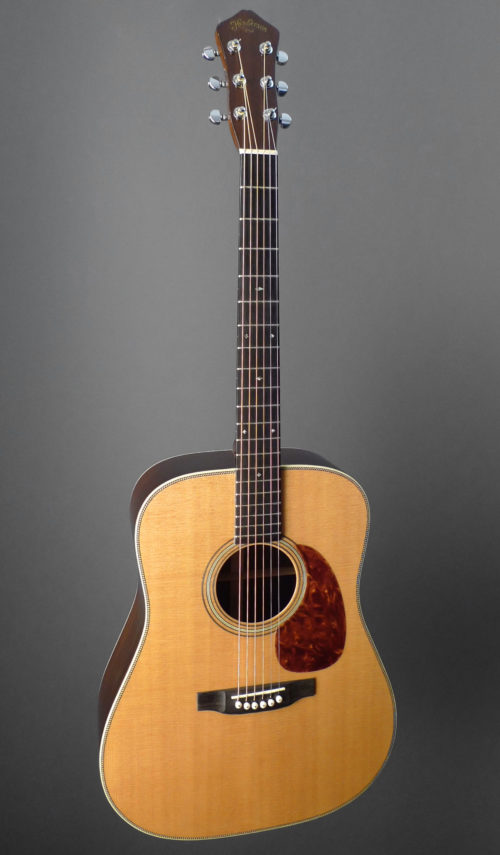 This week, to honor the just-announced winners of the 2018 Wayne Henderson Guitar Festival, we call out not an individual guitar, but rather one of the greatest American luthiers working today– and especially that luthier’s (and great player’s) work for youth in his area. We’re speaking of course of Wayne Henderson, and his legendary Festival. Every June Wayne Henderson hosts on of the most culturally important music festivals in the U.S., at the amphitheater in Grayson Highlands State Park near Henderson’s home and shop in Rugby, Virginia. The guitar- and generally music-loving attendees hear great music while supporting scholarships for young musicians in the area. And at the heart of the festival is the guitar competition. Click here to see the just-announced winners. And here’s a look at Fretboard Journal’s visit to the festival– and to Wayne Henderson’s luthier’s shop– a few years back. Click here for the article. .
This week, to honor the just-announced winners of the 2018 Wayne Henderson Guitar Festival, we call out not an individual guitar, but rather one of the greatest American luthiers working today– and especially that luthier’s (and great player’s) work for youth in his area. We’re speaking of course of Wayne Henderson, and his legendary Festival. Every June Wayne Henderson hosts on of the most culturally important music festivals in the U.S., at the amphitheater in Grayson Highlands State Park near Henderson’s home and shop in Rugby, Virginia. The guitar- and generally music-loving attendees hear great music while supporting scholarships for young musicians in the area. And at the heart of the festival is the guitar competition. Click here to see the just-announced winners. And here’s a look at Fretboard Journal’s visit to the festival– and to Wayne Henderson’s luthier’s shop– a few years back. Click here for the article. . -
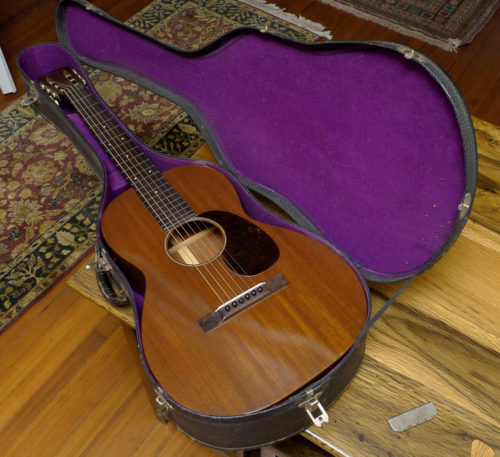 If there is a better-preserved Martin guitar from 1937, we have not seen it. This instrument is as an almost time-capsule condition 0-17H, still in its original case. And of course with its original Hawaiian set up. Many people convert these pre-war Martin Hawaiian set up guitars, to “Spanish” style, i.e. regular steel-string flat top set up. And that is certainly an option for whoever acquires this instrument. But this example, is just too nice, and too original for us to want to convert it. And the tone is exquisite (On request, we’ll send you a link to a video/audio clip of one of this country’s best, most famous dobro/pedal steel players playing slide on this great Martin 0-17H, right here in our shop.) All mahogany of course: mahogany back, sides, and top. Brazilian rosewood bridge, and fretboard. The guitar has no play wear. We won’t call it pristine– even under-the bed-guitars that have not really been played, have a few nicks from just being in the case and moved around a couple of times in 70+ years. But it’s as close to perfect as you’ll find in any 1930’s Martin. The neck is straight as an arrow, showing no bowing at all. No cracks of any kind. All original parts, period– down to the nut, bridge pins, and ivory saddle. The guitar is 12 fret to the body, unlike the regular 0-17’s from this period that were 14-fret.
If there is a better-preserved Martin guitar from 1937, we have not seen it. This instrument is as an almost time-capsule condition 0-17H, still in its original case. And of course with its original Hawaiian set up. Many people convert these pre-war Martin Hawaiian set up guitars, to “Spanish” style, i.e. regular steel-string flat top set up. And that is certainly an option for whoever acquires this instrument. But this example, is just too nice, and too original for us to want to convert it. And the tone is exquisite (On request, we’ll send you a link to a video/audio clip of one of this country’s best, most famous dobro/pedal steel players playing slide on this great Martin 0-17H, right here in our shop.) All mahogany of course: mahogany back, sides, and top. Brazilian rosewood bridge, and fretboard. The guitar has no play wear. We won’t call it pristine– even under-the bed-guitars that have not really been played, have a few nicks from just being in the case and moved around a couple of times in 70+ years. But it’s as close to perfect as you’ll find in any 1930’s Martin. The neck is straight as an arrow, showing no bowing at all. No cracks of any kind. All original parts, period– down to the nut, bridge pins, and ivory saddle. The guitar is 12 fret to the body, unlike the regular 0-17’s from this period that were 14-fret. -
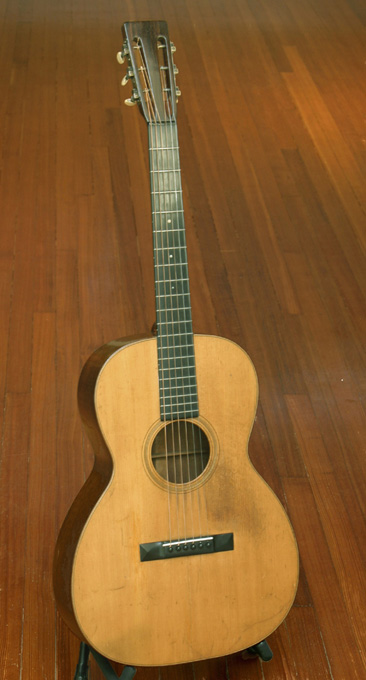 Take Martin’s best era for 12-fret guitars, add more scale length, and you get the best of both worlds–that’s what players say about the 000 sized 12-frets, if they can find one, from the mid to late 20’s. This was the biggest, loudest Martin made for steel strings in this era, with a 25.4 inch scale length, the same scale length as a 30’s D-45! (The 14-fret 000’s of the 30s and later have a shorter, 24.5 inch scale). In no other instrument will you get the resonance (from thin tops and back), combined with the long scale length. It’s a big pre-war Martin 12-fret. That’s why this instrument is a highly sought-after prewar Martin. This crack-free 000-18 has great provenance: acquired from and set up by one of the world’s top Martin experts (in Tuebingen, Germany). 1 7/8” nut. Mahogany back and sides. Adirondack spruce top. Ebony fingerboard. It has original tuners (gear wheel below worm gear, ivoroid buttons), parts, and all original finish. Restoration by TJ Thompson and Dana Bourgeois: correct replacement bridge (ebony pyramid) and bridge plate (maple), and frets replaced (bar frets). Center seam repaired and cleated and touched up (shellack). Neck has been reset. Neck is dead straight, bridge saddle is medium height (allows set up for both higher and lower action if needed in future). Low action, and set up for light or medium gauge strings. The tone could not be better: all the clear separation of the mids that is the hallmark of the 20’s style 18 twelve-fret, but with fuller, louder, rounder bass. One of the most sought-after Martin 12-frets, original finish, crack-free. Restored correctly, cared for, and set up by the world’s best luthiers and vintage Martin experts, and ready to enjoy.
Take Martin’s best era for 12-fret guitars, add more scale length, and you get the best of both worlds–that’s what players say about the 000 sized 12-frets, if they can find one, from the mid to late 20’s. This was the biggest, loudest Martin made for steel strings in this era, with a 25.4 inch scale length, the same scale length as a 30’s D-45! (The 14-fret 000’s of the 30s and later have a shorter, 24.5 inch scale). In no other instrument will you get the resonance (from thin tops and back), combined with the long scale length. It’s a big pre-war Martin 12-fret. That’s why this instrument is a highly sought-after prewar Martin. This crack-free 000-18 has great provenance: acquired from and set up by one of the world’s top Martin experts (in Tuebingen, Germany). 1 7/8” nut. Mahogany back and sides. Adirondack spruce top. Ebony fingerboard. It has original tuners (gear wheel below worm gear, ivoroid buttons), parts, and all original finish. Restoration by TJ Thompson and Dana Bourgeois: correct replacement bridge (ebony pyramid) and bridge plate (maple), and frets replaced (bar frets). Center seam repaired and cleated and touched up (shellack). Neck has been reset. Neck is dead straight, bridge saddle is medium height (allows set up for both higher and lower action if needed in future). Low action, and set up for light or medium gauge strings. The tone could not be better: all the clear separation of the mids that is the hallmark of the 20’s style 18 twelve-fret, but with fuller, louder, rounder bass. One of the most sought-after Martin 12-frets, original finish, crack-free. Restored correctly, cared for, and set up by the world’s best luthiers and vintage Martin experts, and ready to enjoy. -
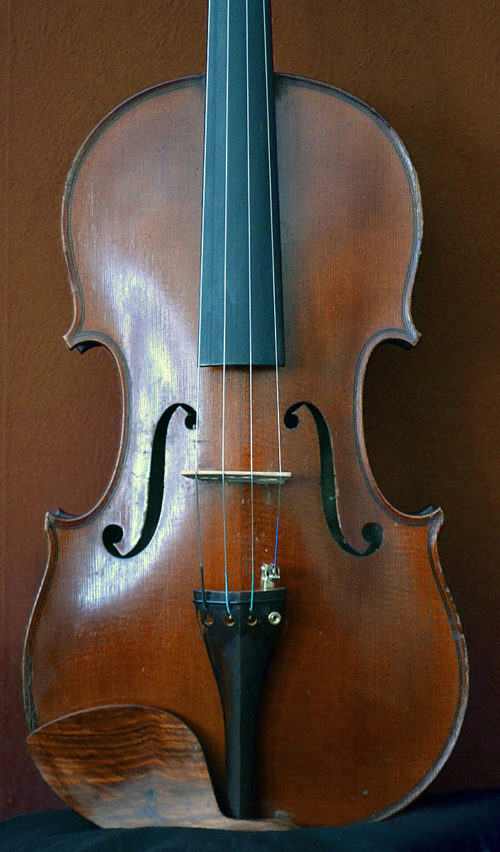 Full size, Charles Fetique violin (French, early 20th century – circa 1930), with original label inside. This is a rich, sonorous instrument. A deep, round tone, that – like all good violins – does not make you work overly hard to attain. It has a darker, lush, round tone that professional players love – and great projection. We recently A-B'd this instrument against $5k+ violins in the area, and there was no comparison, this instrument was louder, more full, more round and full in the bass notes, and all around a stellar performer. This violin would be a great student violin upgrade – for that aspiring violinist who is ready to graduate to, and enjoy, a better instrument than what's typically available in the $4-5K range, at a very attractive price. And, the buyer will have the confidence of both a Letter of Expertise, and a professional appraisal: • Certificate: Jean-Jacques Rampal, Paris, 2014. (This is the letter of expertise, on this violin, from one of the top experts on French Violins, in Paris, France). And: • Written, professional appraisal of the violin, done from personal inspection, from one of the top violin shops/experts in Texas (Jay R. Rury Violins, Dallas), with a valuation of $3,500.00 Both the above documents will be included with the sale. The violin is in excellent condition. There are no sound post, or bass bar cracks. It was professionally set up to play, by Blackerby Violin in Austin. In a modern Tonerelli case. Price: $3250.
Full size, Charles Fetique violin (French, early 20th century – circa 1930), with original label inside. This is a rich, sonorous instrument. A deep, round tone, that – like all good violins – does not make you work overly hard to attain. It has a darker, lush, round tone that professional players love – and great projection. We recently A-B'd this instrument against $5k+ violins in the area, and there was no comparison, this instrument was louder, more full, more round and full in the bass notes, and all around a stellar performer. This violin would be a great student violin upgrade – for that aspiring violinist who is ready to graduate to, and enjoy, a better instrument than what's typically available in the $4-5K range, at a very attractive price. And, the buyer will have the confidence of both a Letter of Expertise, and a professional appraisal: • Certificate: Jean-Jacques Rampal, Paris, 2014. (This is the letter of expertise, on this violin, from one of the top experts on French Violins, in Paris, France). And: • Written, professional appraisal of the violin, done from personal inspection, from one of the top violin shops/experts in Texas (Jay R. Rury Violins, Dallas), with a valuation of $3,500.00 Both the above documents will be included with the sale. The violin is in excellent condition. There are no sound post, or bass bar cracks. It was professionally set up to play, by Blackerby Violin in Austin. In a modern Tonerelli case. Price: $3250. -
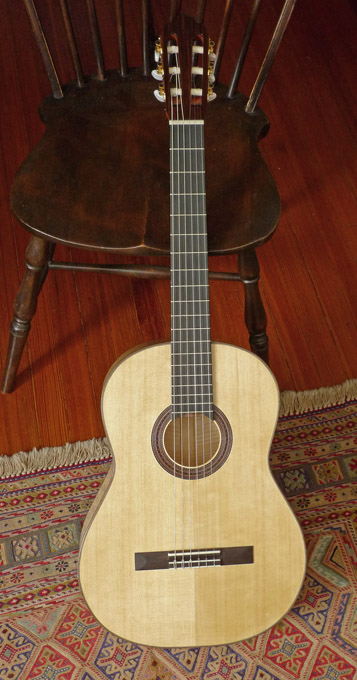 Joseph Redman, based in Abingdon, VA, makes some nice, hand made, yet affordable classical and flamenco guitars. Their low price tags don’t reflect the quality of materials in each instrument. This was a custom order, featuring European Maple back and sides, and all hand French polished by Redman. Nice, rumbling bass response. The Maple tone here, doesn’t show up in the trebles as much as it does in the bass– adding a Maple crispness to the bass strings.
Joseph Redman, based in Abingdon, VA, makes some nice, hand made, yet affordable classical and flamenco guitars. Their low price tags don’t reflect the quality of materials in each instrument. This was a custom order, featuring European Maple back and sides, and all hand French polished by Redman. Nice, rumbling bass response. The Maple tone here, doesn’t show up in the trebles as much as it does in the bass– adding a Maple crispness to the bass strings.- Finish: hand-rubbed French Polish
- 650mm Scale length
- European Maple back and sides
- Canadian Spruce top
- Ebony fretboard
- Neck: Spanish Cedar
- Bindings:
-
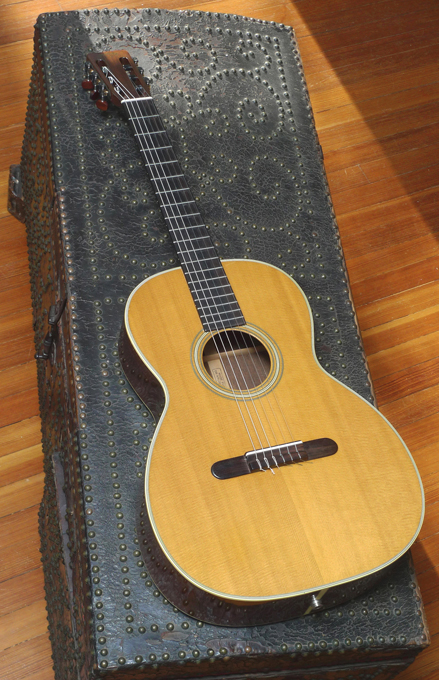 A wonderfully preserved, crack free 12 fret 000-28 Martin, with gorgeous Brazilian rosewood back and sides. The tone of this instrument is wonderful. It stands up to many high end Spanish made classical guitars of the period for Brazilian rosewood warmth. While intentionally not built for concert hall volume, the bass tone and clarity of the trebles on large-bodied Martin nylon strings guitars with Brazilian back and sides is unsurpassed. This instrument is very well set up to play on stage, plugged in, and to record, if desired. It has great high end Gilbert tuners, with black housing, abalone dot and snakewood buttons. (Original tuners, in perfect condition, are in the case, so you can easily replace the originals if desired.) This instrument has an excellent custom engineered stereo pickup system, installed without altering the guitar: The pickup is the undersaddle type, supplied by EMG. The separate mic element is assembled in a foam mounting block with cable, endpin jack, custom made for this guitar. It is unobtrusive in its mounting. Jack is mounted in the endpin hole, so there are no extra holes in the guitar. The output jack is stereo, TRS (Tip wired to pickup, Ring wired to mic, and Sleeve is ground.) The addition of the internal mic adds a realism and depth that no pickup by itself can capture. The EMG pickup is excellent compared to most others in terms of exhibiting less of that harsh piezo sound. The result is a guitar that plays beautifully amplified, or on its own. The Martin “C” has the old elongated Martin 12 fret body. It was offered in the 00-16C, 00-18C and 000-28C in 1962. 1966 saw the last 000-28C. There were not many nylon string, 000-sized 28 models made, and fewer still with the quality of Brazilian rosewood this one has. And the condition on this instrument is stunning. No cracks anywhere, and very little wear at all.
A wonderfully preserved, crack free 12 fret 000-28 Martin, with gorgeous Brazilian rosewood back and sides. The tone of this instrument is wonderful. It stands up to many high end Spanish made classical guitars of the period for Brazilian rosewood warmth. While intentionally not built for concert hall volume, the bass tone and clarity of the trebles on large-bodied Martin nylon strings guitars with Brazilian back and sides is unsurpassed. This instrument is very well set up to play on stage, plugged in, and to record, if desired. It has great high end Gilbert tuners, with black housing, abalone dot and snakewood buttons. (Original tuners, in perfect condition, are in the case, so you can easily replace the originals if desired.) This instrument has an excellent custom engineered stereo pickup system, installed without altering the guitar: The pickup is the undersaddle type, supplied by EMG. The separate mic element is assembled in a foam mounting block with cable, endpin jack, custom made for this guitar. It is unobtrusive in its mounting. Jack is mounted in the endpin hole, so there are no extra holes in the guitar. The output jack is stereo, TRS (Tip wired to pickup, Ring wired to mic, and Sleeve is ground.) The addition of the internal mic adds a realism and depth that no pickup by itself can capture. The EMG pickup is excellent compared to most others in terms of exhibiting less of that harsh piezo sound. The result is a guitar that plays beautifully amplified, or on its own. The Martin “C” has the old elongated Martin 12 fret body. It was offered in the 00-16C, 00-18C and 000-28C in 1962. 1966 saw the last 000-28C. There were not many nylon string, 000-sized 28 models made, and fewer still with the quality of Brazilian rosewood this one has. And the condition on this instrument is stunning. No cracks anywhere, and very little wear at all. -
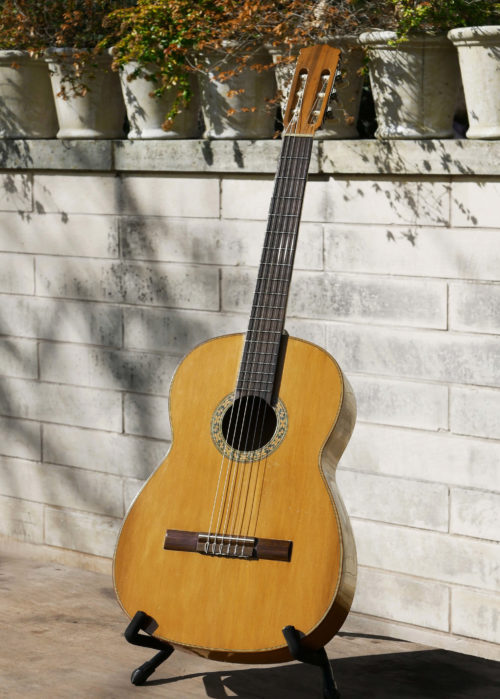 Another instrument from Enos Hernandez of Mexico, one of the best luthiers to ever live in work in Mexico, circa 1970’s. This one is a flamenco Blanca, with the classic cypress back and sides. Like the other Enos Hernandez we have, this one also has a cedar top. The instrument is super light weight, as a Flamenco Blanca should be, and it’s bright and percussive and raspy as a good Blanca should be. There is a scratch (not a crack) on back of guitar (see photo). There are dot position markers – original to the guitar, i.e. not added later – on top edge of fretboard (frets 3,5,7,9 – see photo). Scale length: 660mm Available January 2018 Price: $2950
Another instrument from Enos Hernandez of Mexico, one of the best luthiers to ever live in work in Mexico, circa 1970’s. This one is a flamenco Blanca, with the classic cypress back and sides. Like the other Enos Hernandez we have, this one also has a cedar top. The instrument is super light weight, as a Flamenco Blanca should be, and it’s bright and percussive and raspy as a good Blanca should be. There is a scratch (not a crack) on back of guitar (see photo). There are dot position markers – original to the guitar, i.e. not added later – on top edge of fretboard (frets 3,5,7,9 – see photo). Scale length: 660mm Available January 2018 Price: $2950 -

-
 This extraordinary guitar, completed by C.T. Beitel in June of 1894, is signed and dated by him on the underside of the top. The guitar is in remarkably original condition. And it plays wonderfully. C.T. Beitel (Clemence T. Beitel, 1869-1916) was closely associated with C.F. Martin & Co. in the 1890’s. The Beitels are well known to have been closely associated with the Martin family in these years, both personally (including through marriage) and in the Martin guitar business. According to some correspondence and background research from family members obtained with this guitar, C.T. Beitel was the first American-born person to serve an apprenticeship at Martin Guitars. C.T. Beitel was a cousin to C.A. Zoebisch– who was of course the famous Martin guitar distributor and sometimes-partner of C.F. Martin & Co. in this period. Although this guitar is strikingly faithful to Martin specs, this is most likely one of C.T. Beitel’s guitars made by him to market separately from Martin. It is documented that at least one of the Beitel family had an ongoing guitar making and marketing business in the late 1890’s. Is this Beitel guitar one of the first made under the “Beitel” name? Certainly. Are there others remaining today? There are none known of by us–making this a rare and highly collectible guitar. Similar to a Martin 2-27… but not exactly. More like a cross between a 2-27, a “28” style–because of the wonderful Herringbone purfling/binding on the top– and a 30’s or higher style with its very fancy Jerome tuners.
This extraordinary guitar, completed by C.T. Beitel in June of 1894, is signed and dated by him on the underside of the top. The guitar is in remarkably original condition. And it plays wonderfully. C.T. Beitel (Clemence T. Beitel, 1869-1916) was closely associated with C.F. Martin & Co. in the 1890’s. The Beitels are well known to have been closely associated with the Martin family in these years, both personally (including through marriage) and in the Martin guitar business. According to some correspondence and background research from family members obtained with this guitar, C.T. Beitel was the first American-born person to serve an apprenticeship at Martin Guitars. C.T. Beitel was a cousin to C.A. Zoebisch– who was of course the famous Martin guitar distributor and sometimes-partner of C.F. Martin & Co. in this period. Although this guitar is strikingly faithful to Martin specs, this is most likely one of C.T. Beitel’s guitars made by him to market separately from Martin. It is documented that at least one of the Beitel family had an ongoing guitar making and marketing business in the late 1890’s. Is this Beitel guitar one of the first made under the “Beitel” name? Certainly. Are there others remaining today? There are none known of by us–making this a rare and highly collectible guitar. Similar to a Martin 2-27… but not exactly. More like a cross between a 2-27, a “28” style–because of the wonderful Herringbone purfling/binding on the top– and a 30’s or higher style with its very fancy Jerome tuners.- No “Martin” stamps anywhere
- “C.T. Beitel” paper label on neck block (Martin stamp beneath the label? Uncertain)
- Signed and dated on underside of top: “C.T. Beitel, 6/94, Easton” (i.e. Easton, PA)
- X-braced top
- All original finish; no touch-ups etc
- Pearl inlay around sound hole
- Herringbone purfling around top
- Real Ivory binding, top, and back
- Bound Ivory neck
- Ebony bridge
- Ebony fretboard (bound in Ivory)
- Original Maple bridge plate
- Size: a just bit bigger at lower bout than a Martin “2” size: 12 1/4 inches
- Scale length: 24 3/4 inches
- Body length: 18 3/8 inches
- String spacing at bridge: 2 3/8 inches - Nut width: 1 7/8 inches
- Body depth at bottom of guitar: 4 inches
- Top: Adirondack Spruce
- Back and sides: solid Brazilian Rosewood
- Neck: Cedar
- Headstock: Brazilian Rosewood veneer
- Tuners: original, German-made Jerome tuners, with fancy flower engraving, and oval shaped Ivory tuner buttons. These tuners are typically found only on the highest model Martin guitars of those years
- Tuner buttons: Ivory, oval-shaped
-
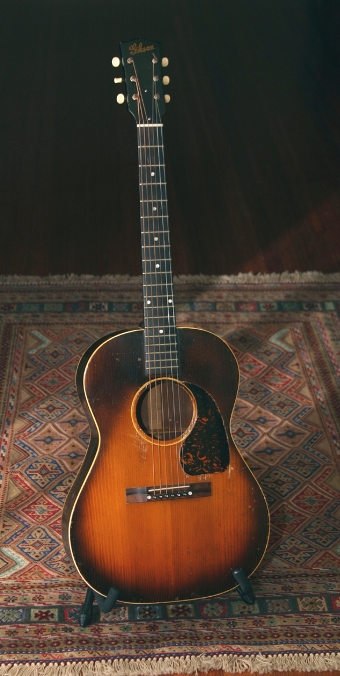 (No serial number or FON, these years often do not have one.) This completely crack-free, Script logo LG-2 is a jewel. A lot of players say the script logo Gibsons from right after the war are better sounding and better-built guitars than the Banner Gibsons. All of the good things about Banners, but with better craftsmanship. All original finish, everywhere. Mahogany back and sides. Spruce top. Not a crack anywhere. 1-3/4" nut. The bridge is an excellent quality rosewood replacement. Original maple plate. Original tuners. Replaced nut and saddle. Rosewood fingerboard shows moderate wear on first couple of frets. Some of that wonderful Gibson 40’s crazing to the finish, but not at all out of hand. Various pick marks, and dings. Original tuners, bridge, plate. Piezo pickup was skillfully de-installed, and endpin jack removed and plugged. One of the finest Script logo LG-2s you’ll find.
(No serial number or FON, these years often do not have one.) This completely crack-free, Script logo LG-2 is a jewel. A lot of players say the script logo Gibsons from right after the war are better sounding and better-built guitars than the Banner Gibsons. All of the good things about Banners, but with better craftsmanship. All original finish, everywhere. Mahogany back and sides. Spruce top. Not a crack anywhere. 1-3/4" nut. The bridge is an excellent quality rosewood replacement. Original maple plate. Original tuners. Replaced nut and saddle. Rosewood fingerboard shows moderate wear on first couple of frets. Some of that wonderful Gibson 40’s crazing to the finish, but not at all out of hand. Various pick marks, and dings. Original tuners, bridge, plate. Piezo pickup was skillfully de-installed, and endpin jack removed and plugged. One of the finest Script logo LG-2s you’ll find. -
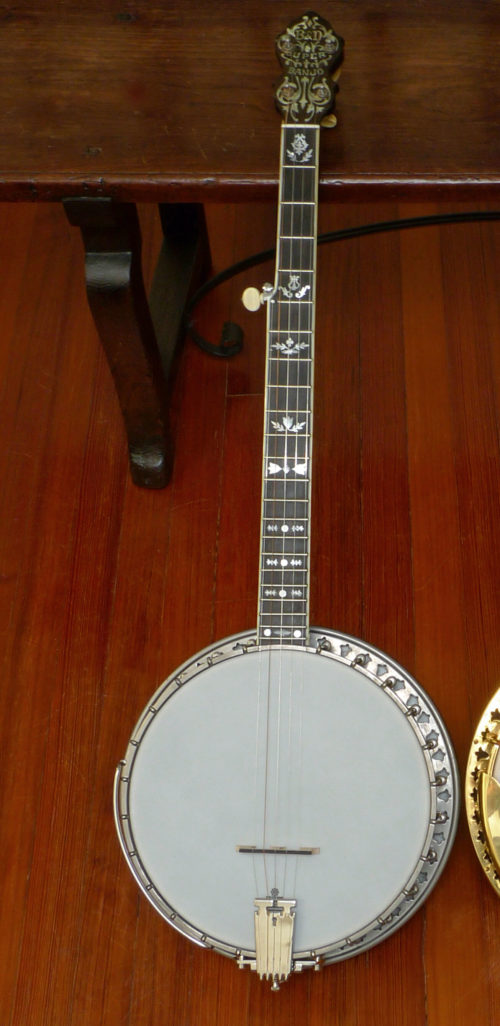 This is a superb sounding 5 string banjo. Original nickel plating. • Bacon & Day Super, 5-string Banjo (Style A) Serial number: 25892 (early 1928) • Resonator, stamped on inside (in nickel-laminated maple): Bacon Banjo Co., Inc. Groton, CT. U.S.A. Dec. 20th, 1927 • Conversion, 5 string neck (original neck was probably a tenor or plectrum); Presumably, this neck is newer than the banjo– yet the advanced MOP fret markers are as found on the earliest versions of B&D Super banjos. We assume this neck was built by one of the best U.S. “conversion” builders – with a re-use of the original MOP inlay at the peghead plus the dowel stick. Maple neck, with steel reinforcing rod. Fretboard is beautiful jet-black ebony; multi-layer neck bindings. Fretboard is a very comfortable 1 3/8 inches wide at the nut, 1 7/8 wide where fretboard meets body. • Nickel plated • 22 frets • Scale length: 27 inches • Extended Maple resonator– nickel laminated on inside • Original flat Tulip-hole flange (not the “add-on” round-hole resonator of earlier years). • Original, top of the line Type III Silver Bell tone ring (No Hole tone ring) original to the instrument (this is the most sought-after, advanced Silver Bell tone ring, introduced early 1927). • Original 2 band Grover geared tuning pegs • Fults tailpiece, and included a variety of Fults tone pins. Bob Fults made the best tailpieces available. And his tone pins let you tweak the tone of your banjo. There are several interchangeable Fults pins included here– ivory, ebony, lead, sterling silver, brass, and copper. Plus a “tone lock”. (Bob Fults recently retired, and these highly sought after Fults tailpieces and pins are no longer available.) In its original hard shell Lifton case. $3750.
This is a superb sounding 5 string banjo. Original nickel plating. • Bacon & Day Super, 5-string Banjo (Style A) Serial number: 25892 (early 1928) • Resonator, stamped on inside (in nickel-laminated maple): Bacon Banjo Co., Inc. Groton, CT. U.S.A. Dec. 20th, 1927 • Conversion, 5 string neck (original neck was probably a tenor or plectrum); Presumably, this neck is newer than the banjo– yet the advanced MOP fret markers are as found on the earliest versions of B&D Super banjos. We assume this neck was built by one of the best U.S. “conversion” builders – with a re-use of the original MOP inlay at the peghead plus the dowel stick. Maple neck, with steel reinforcing rod. Fretboard is beautiful jet-black ebony; multi-layer neck bindings. Fretboard is a very comfortable 1 3/8 inches wide at the nut, 1 7/8 wide where fretboard meets body. • Nickel plated • 22 frets • Scale length: 27 inches • Extended Maple resonator– nickel laminated on inside • Original flat Tulip-hole flange (not the “add-on” round-hole resonator of earlier years). • Original, top of the line Type III Silver Bell tone ring (No Hole tone ring) original to the instrument (this is the most sought-after, advanced Silver Bell tone ring, introduced early 1927). • Original 2 band Grover geared tuning pegs • Fults tailpiece, and included a variety of Fults tone pins. Bob Fults made the best tailpieces available. And his tone pins let you tweak the tone of your banjo. There are several interchangeable Fults pins included here– ivory, ebony, lead, sterling silver, brass, and copper. Plus a “tone lock”. (Bob Fults recently retired, and these highly sought after Fults tailpieces and pins are no longer available.) In its original hard shell Lifton case. $3750. -
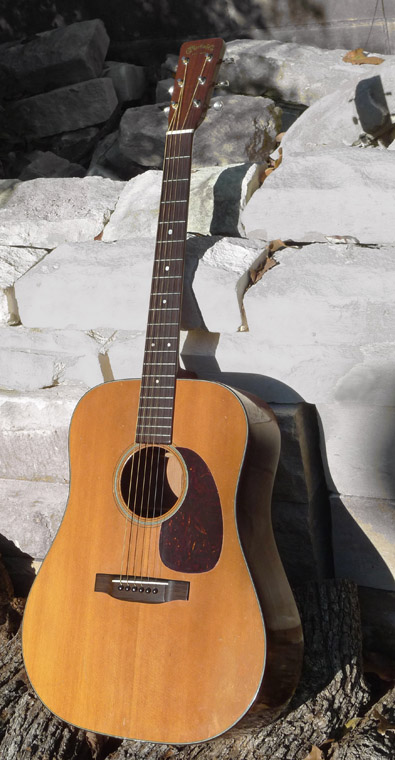 This is another great mid-fifties dread in unbelievable condition. It’s totally crack-free (also, not even a “pick guard” crack). Was acquired in 100% original condition: bridge, saddle, bridge pins, tuners, everything. Just had a neck set– resulting in great action, and tone/projection. With new condition Martin hard shell case.
This is another great mid-fifties dread in unbelievable condition. It’s totally crack-free (also, not even a “pick guard” crack). Was acquired in 100% original condition: bridge, saddle, bridge pins, tuners, everything. Just had a neck set– resulting in great action, and tone/projection. With new condition Martin hard shell case.